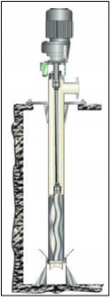By Jeff Bye, Director, Netzsch Pumps North America, LLC
As part of a major overhaul, the JFK International Airport recently completed an extensive redesign of an aging storage and transfer system for de-icing fluids used in winter operations. The new system includes an immersible progressing cavity (PC) pump that can be installed vertically inside an underground storage tank (UST), offering space savings that reduced infrastructure construction costs considerably. The pump handles the viscous de-icing Type IV deicing fluid with ease, while also offering numerous maintenance benefits and health and safety advantages. The new fluid storage and transfer system design is being considered for other terminals as budgets permit.
JFK International Airport seeks to replace outdated glycol storage and transfer system
Port Authority of New York and New Jersey (Port Authority) recently unveiled a $10 billion plan to transform the aging John F. Kennedy International Airport into a world-class hub with easy access. Ranked 59th out of the world’s top 100 international airports, JFK International sees more than 60 million people passing through its doors each year and expects that number to rise to 75 million a year by 2030 and 100 million by 2050.
One of the upgrades targeted for the first wave of projects was Terminal #1’s deicing/anti-icing storage and fluid transfer system for winter operations. The existing system included one 15,000-gallon UST for viscous Type IV anti-icing fluid, one 40,000 gallon UST for non-viscous deicing fluid, and an adjacent truck loading island. Originally put in place in 1996, the system had exceeded its lifespan. The decision to upgrade the operation was based primarily on its outdated tank design. The 15,000 gallon tank was compartmented into a 10,000 gallon tank with a 5,000 gallon compartment housing two horizontal progressing caving pump reducing the Type IV fluid storage capacity to 10,000 gallons. Terminal One was looking for a redesign that provided 100 percent of the gross capacity (15,000 gallons).
The original horizontal pumps inside the empty tank compartment were also very difficult to service. The initial system employed conventional dry pumps installed in a chamber inside the tank. To gain access for service, employees had to descend through a 3-foot diameter manway into vertical passage. The relative inaccessibility had become a maintenance issue and raised potential health and safety considerations. The 15,000-gallon tanks in the original system design required a confined space entry and made accessibility to the equipment very difficult.
As part of the facility upgrade initiative, Terminal One worked with the design engineering firm Eryou Engineering to develop a recommendation for a replacement system. The company, which designs aviation fueling systems in New York City and across the US, has extensive experience at local airports, including JFK, LaGuardia, and Newark. They had also designed several smaller deicing systems for Southwest Airlines for LGA, BOS, BUF. Eryou Engineering provided the design, permitting, construction phase inspections, and final signoff for the project.
Deicing fluids are supplied in a variety of types. The system JFK was replacing stores UCAR™ Aircraft Deicing/Anti-icing Fluid ULTRA+, an propylene glycol-based Type 1 and Type IV fluid containing water, corrosion inhibitors, wetting agents, thickeners, and green dye. Type IV fluids keep ice from reforming when planes are taking off, and is extremely viscous. It produces a thicker layer on an aircraft surface than aircraft deicing fluid.
According to consulting engineer Dennis Eryou, PhD, PE, the viscous Type 4 glycol anti-icing liquid has a viscosity of approximately 30,000 centipoise (cP), which makes it similar to blood viscosity. “We knew we needed a low turbulence pumping system to ensure the shear sensitive fluid properties are not destroyed,” said Eryou.
Finding the right pump
In addition to getting extra tank capacity and improving access for servicing, Terminal One wanted to fit the entire system within the existing footprint while meeting all flow rate and pressure requirements. They were looking to reduce costs by reusing the existing tank’s bottom slab and sheathing to install the new tank. This meant the pump would have to fit in a tight space with minimal changes from the existing design.
The consulting engineers looked at a variety of vertical pump options, including vertical centrifugal pumps. These are widely used for Type I deicing, which uses a water-like substance. However, the thicker, more viscous and shear sensitive Type IV liquid being pumped is not well-handled by centrifugal pumps. The A centrifugal pump would have created high shear for the product, greatly reducing its viscosity and effectiveness.
During the research, Eryou Engineering came upon information about the NEMO® BT Immersible Pump, a progressing cavity pump with integral mounting plate, manufactured by NETZSCH. The pump can be used for shear-sensitive substances with high viscosities. Eryou had heard of NETZSCH by reputation and contacted the local NETZSCH distributor Burt Process Equipment, a Hamden, CT-based manufacturer and supplier of industrial products and engineered systems.
Dave Carson, Burt Process Equipment’s national sales manager, explains that the company worked closely with the design engineer to develop a design that would provide the financial savings they were looking for while meeting the system requirements for the viscous liquid. The system flow rate was approximately 50 gallons per minute, with a discharge pressure of 50 pounds per square inch, a specific gravity of 1.11, and temperature ranges from 32°F to 65°F.
“The NEMO was head and shoulders above the other options we considered,” said Eryou. “In addition, none of the other options could be mounted in the vertical position necessary for this application. This was really a driving factor in the project.”
Two pumps would be required for each UST, which would be installed directly into a tank top manway in the 15,000-gallon storage tanks. The design eliminated the need for installing a tank bulkhead/compartment just to house the pumps.
Explains Carson, “With this design, there is no need for an underground containment tank for the pump, no access ladder to walk down, and no manway/hatchway. The vertical pump means it is accessible from grade. This allows the pump to simply be pulled out of the tank vertically –including the electrical portion. The design makes all areas of the motor available and provides easy access. Also, there would be no Occupational Safety and Health Administration (OSHA) permit-required confined spaces.”
Carson worked with NETZSCH to get pricing and technical data. NETZSCH quickly put together a package with the quotation, drawings, and everything needed to implement the project. The consulting engineer said working with Burt and NETZSCH was very efficient. “We gave them a drawing of the tank and the dimensions and told them they had to fit it in. They came back with two or three options and within a couple of days we had nailed it down.”
The NEMO® BT Immersible Pump they selected had numerous advantages for this application. In addition to its space saving installation within the tank, it offered low vibration and silent operation. Also, there are no shaft seals on the suction side – instead Teflon packing is fitted with a lantern ring. This means there are fewer parts to worry about damaging, and a definite financial saving. The pump easily handles the 30,000 cP viscosity requirement, and it comes with top and bottom mounting plates to provide optimum support.
Installation, start-up, training, and field service support
Working closely with the design engineer, NETZSCH and Burt Process Equipment provided pump design and selection, fabrication, installation, start-up, training, and field service support. Burt’s field service engineers completed installation of the pumps and variable frequency drives. NETZSCH supported Burt by verifying the application was correct as was the sizing and pump selection. They provided documentation and reviewed technical and installation drawings to ensure they are correct.
“It’s good to be smart and lucky; we picked the right company right out of box,” said Eryou. NETZSCH delivered and everything ran smoothly and has been running like a clock ever since.”
Future replacement in the cards
The Terminal #1 project was completed in March 2017. It is one of five terminal deicing system replacement projects slated for completion over the next decade, pending infrastructure budget approval. Burt is confident these future projects will also use the NEMO pumps.





